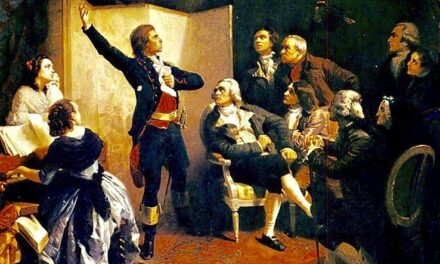We support our Publishers and Content Creators. You can view this story on their website by CLICKING HERE.
Moderns often believe they are great discoverers and inventors, yet remain ignorant of the meaning and significance of the ancient intellectual monuments of Antiquity and the Middle Ages. This is a lesson upon which we can never meditate enough and a good argument in favor of seriously undertaking classical studies and ancient history.
We probably all remember—even those of us who are not active in the fields of exact sciences or engineering—the famous fifth postulate of Euclid, which states that through a point not on a line, there is only one line parallel to the given line. Up to this point, everything seems simple and clear. So clear, in fact, that children learn this postulate in school, alongside the Pythagorean theorem and other such mathematical marvels. Things begin to get complicated when, in the first half of the 19th century, two brilliant mathematicians lay the foundations of the so-called “non-Euclidean” geometry.
In 1829, the Russian scientist Nikolai Ivanovich Lobachevsky, and later in 1832, the Hungarian mathematician János Bolyai, published works deviating from the principles of Euclidean geometry, proposing a geometric vision of a hyperbolic space in which, simply put, there are no parallel lines in the Euclidean sense. Without delving into the details of the remarkable speculations developed within the context of modern mathematics, I emphasize an unexpected possibility: the two thinkers fundamentally erred. This is a serious critique, isn’t it? What exactly was their mistake? It is not at all an error of logic or calculation! Rather, it is an error of interpretation resulting from the most common flaw found in most contemporary scientists: the complete disregard for the original significance of ancient notions inherited by modern science from authors such as Euclid (circa 365 – 275 BC).
Seeing how ancient and medieval medicine (for instance, that of Saint Hildegard of Bingen), classical physics (before Newton and Descartes), astronomy, astrology, alchemy, arithmetic, and geometry are treated in most history of science textbooks, we quickly realize that most contemporary authors and scholars are in too much of a hurry to read the original sources and strive to understand them in the context of their discovery. This is why Émile Littré probably experienced a shock when he discovered the unimaginable richness of the Hippocratic Corpus—of which, I fear, almost no doctor today has the curiosity to read even five pages. Ancient testimonies from the Jewish, Egyptian, Chinese, Chaldean, pre-Columbian, Indian, Greek, or Latin worlds are treated with equal (dis)regard, being crammed in a few dry lines in treatises where 90% of the space is devoted exclusively to discoveries of the last centuries. We are practically witnessing a true rupture, if not a denial of monumental visions of the world, man, and life, which might far exceed everything we imagine we have conquered and discovered in recent centuries.
The same is true for non-Euclidean geometry. Without deeply reflecting on the profound meanings of Euclid’s conception, the two mathematicians imagined they could construct a theoretical edifice by negating something they had never fully understood. If it seems I am speaking too easily against concepts accepted by many of today’s scholars, I hasten to reveal the reason.
Specifically, it is a small work, Le postulat chez Euclide et chez les modernes (The Postulate in Euclid and the Moderns), written by Professor Aram Frenkian and published in 1940 by J. Vrin in Paris. Displaying exactly the skepticism towards non-Euclidean theory that we have expressed above, the mentioned author, a brilliant Romanian classicist (with solid knowledge in mathematics) who left us erudite works about the Homeric world, the pre-Socratic philosophers, and doxographers like Diogenes Laertius, systematically analyzes the significance of the famous postulate by contextualizing it. His conclusions are unequivocal. Firstly, he shows that arithmetic (the science of numbers) and geometry (the science of the shape of bodies) had—in the context of the Platonic epistemology in which Euclid’s theory was inscribed—a completely different significance than the one we assign to them today.
To be more explicit, I will mention some of the principles of Platonic philosophy generated by its ultimate (or primary) goal: the contemplation of the world of ideas and the Creator God of everything that exists (called by Plato the “Demiurge”). Related to this supreme, extra-terrestrial goal (for it truly implied a “flight” from the material world to the invisible, intelligible dimension of the world), knowledge was structured in harmony with three main disciplines: geometry, arithmetic, and dialectics. While dialectics was reserved for those advanced on the path to perfection, with an age (specified in the dialogue Politeia) over forty, arithmetic and geometry were intermediate, lower levels of knowledge. They had a propedeutic character—that is, they were meant to prepare the soul of the practitioner for the contemplative “leap” to the noetic heaven. In other words, arithmetic and geometry had an eminently contemplative purpose, foreign to the vision we have of them today.
Only by assuming the correct vision can we explain one of the most famous testimonies regarding Thales, the first of the Greek philosophers, who, when he managed to inscribe a right triangle in a circle, sacrificed an ox to the gods. What connection can there be between a simple geometric operation, which today any sixth-grade student knows, and the sacrifice to the gods? We can understand such a gesture only if we admit that geometry had another purpose, a religious-contemplative one, than the one we know, as prisoners of a materialist-physicalist view of the world and science.
For Plato and his followers—among whom Euclid held a prominent place in the Academy—mathematics had a goal that modern man seems to have forgotten, willingly or not. This is precisely what Professor Aram M. Frenkian systematically demonstrates, who, after providing us with a personal translation (in French) of the first part of Euclid’s Elements, restores their true significance, showing that Lobachevsky and Bolyai never understood the real significance of the fifth postulate.
However, a question remains: how is it that so many scientists and historians of science have not seen what Aram Frenkian seems to have revealed so convincingly? The answer is found on page 9 of the mentioned work, where we first find the following question: “La Perfection este-elle au début ou à la fin?” (“Is Perfection at the beginning or the end?”) From here, Frenkian acknowledges that unlike modern researchers, who have a particular sympathy for the ideas of evolution and indefinite progress, he shares another point of view, specific to Saint Augustine and the great ancient traditions, according to which the perfection of knowledge is found at the beginning of humanity, not at the end.
More concretely, the knowledge that Adam and Eve had in Paradise before the fall was far superior to all the forms of knowledge accessible to us. Obviously, the only exception can be the proper Christian contemplative life, but which only rarely and briefly can rise to that prelapsarian level. Assuming this perspective on history, Professor Aram Frenkian demonstrates that moderns often believe they are great discoverers and inventors, like Lobachevsky and Bolyai, yet remain ignorant of the meaning and significance of the ancient intellectual monuments of Antiquity and the Middle Ages. This is a lesson upon which we can never meditate enough and a good argument in favor of seriously undertaking classical studies and ancient history.
The Imaginative Conservative applies the principle of appreciation to the discussion of culture and politics—we approach dialogue with magnanimity rather than with mere civility. Will you help us remain a refreshing oasis in the increasingly contentious arena of modern discourse? Please consider donating now.
The featured image is “‘Euclid of Megara,’ Panel from the Series ‘Famous Men’ (about 1474), by Justus of Ghent, and is in the public domain, courtesy of Wikimedia Commons.

 Conservative
Conservative  Search
Search Trending
Trending Current News
Current News 






